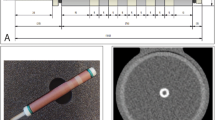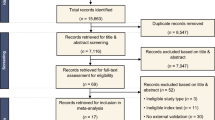Abstract
Objectives
To validate an artificial intelligence (AI)–based fully automatic coronary artery calcium (CAC) scoring system on non-electrocardiogram (ECG)–gated low-dose chest computed tomography (LDCT) using multi-institutional datasets with manual CAC scoring as the reference standard.
Methods
This retrospective study included 452 subjects from three academic institutions, who underwent both ECG-gated calcium scoring computed tomography (CSCT) and LDCT scans. For all CSCT and LDCT scans, automatic CAC scoring (CAC_auto) was performed using AI-based software, and manual CAC scoring (CAC_man) was set as the reference standard. The reliability and agreement of CAC_auto was evaluated and compared with that of CAC_man using intraclass correlation coefficients (ICCs) and Bland-Altman plots. The reliability between CAC_auto and CAC_man for CAC severity categories was analyzed using weighted kappa (κ) statistics.
Results
CAC_auto on CSCT and LDCT yielded a high ICC (0.998, 95% confidence interval (CI) 0.998–0.999 and 0.989, 95% CI 0.987–0.991, respectively) and a mean difference with 95% limits of agreement of 1.3 ± 37.1 and 0.8 ± 75.7, respectively. CAC_auto achieved excellent reliability for CAC severity (κ = 0.918–0.972) on CSCT and good to excellent but heterogenous reliability among datasets (κ = 0.748–0.924) on LDCT.
Conclusions
The application of an AI-based automatic CAC scoring software to LDCT shows good to excellent reliability in CAC score and CAC severity categorization in multi-institutional datasets; however, the reliability varies among institutions.
Key Points
• AI-based automatic CAC scoring on LDCT shows excellent reliability with manual CAC scoring in multi-institutional datasets.
• The reliability for CAC score–based severity categorization varies among datasets.
• Automatic scoring for LDCT shows a higher false-positive rate than automatic scoring for CSCT, and most common causes of a false-positive are image noise and artifacts for both CSCT and LDCT.


Similar content being viewed by others
Abbreviations
- AI:
-
Artificial intelligence
- CAC:
-
Coronary artery calcium
- CAC_auto:
-
Automatic coronary artery calcium scoring
- CAC_man:
-
Manual coronary artery calcium scoring
- CSCT:
-
Calcium scoring computed tomography
- DL:
-
Deep learning
- LAD:
-
Left anterior descending artery
- LCX:
-
Left circumflex artery
- LDCT:
-
Low-dose computed tomography
- LM:
-
Left main artery
- RCA:
-
Right coronary artery
References
Detrano R, Guerci AD, Carr JJ et al (2008) Coronary calcium as a predictor of coronary events in four racial or ethnic groups. N Engl J Med 358:1336–1345
Greenland P, LaBree L, Azen SP, Doherty TM, Detrano RC (2004) Coronary artery calcium score combined with Framingham score for risk prediction in asymptomatic individuals. JAMA 291:210–215
Arad Y, Goodman KJ, Roth M, Newstein D, Guerci AD (2005) Coronary calcification, coronary disease risk factors, C-reactive protein, and atherosclerotic cardiovascular disease events: the St. Francis Heart Study. J Am Coll Cardiol 46:158–165
Reiter MJ, Nemesure A, Madu E, Reagan L, Plank A (2018) Frequency and distribution of incidental findings deemed appropriate for S modifier designation on low-dose CT in a lung cancer screening program. Lung Cancer 120:1–6
Jacobs PC, Gondrie MJ, van der Graaf Y et al (2012) Coronary artery calcium can predict all-cause mortality and cardiovascular events on low-dose CT screening for lung cancer. AJR Am J Roentgenol 198:505–511
Mets OM, Vliegenthart R, Gondrie MJ et al (2013) Lung cancer screening CT-based prediction of cardiovascular events. JACC Cardiovasc Imaging 6:899–907
Chiles C, Duan F, Gladish GW et al (2015) Association of coronary artery calcification and mortality in the National Lung Screening Trial: a comparison of three scoring methods. Radiology 276:82–90
Shemesh J, Henschke CI, Shaham D et al (2010) Ordinal scoring of coronary artery calcifications on low-dose CT scans of the chest is predictive of death from cardiovascular disease. Radiology 257:541–548
Phillips WJ, Johnson C, Law A et al (2019) Comparison of Framingham risk score and chest-CT identified coronary artery calcification in breast cancer patients to predict cardiovascular events. Int J Cardiol 289:138–143
Budoff MJ, Lutz SM, Kinney GL et al (2018) Coronary artery calcium on noncontrast thoracic computerized tomography scans and all-cause mortality. Circulation 138:2437–2438
Jacobs PC, Gondrie MJ, Mali WP et al (2011) Unrequested information from routine diagnostic chest CT predicts future cardiovascular events. Eur Radiol 21:1577–1585
Shao L, Yan AT, Lebovic G, Wong HH, Kirpalani A, Deva DP (2017) Prognostic value of visually detected coronary artery calcification on unenhanced non-gated thoracic computed tomography for prediction of non-fatal myocardial infarction and all-cause mortality. J Cardiovasc Comput Tomogr 11:196–202
Hecht HS, Cronin P, Blaha MJ et al (2017) 2016 SCCT/STR guidelines for coronary artery calcium scoring of noncontrast noncardiac chest CT scans: a report of the Society of Cardiovascular Computed Tomography and Society of Thoracic Radiology. J Cardiovasc Comput Tomogr 11:74–84
Schwarz F, Nance JW Jr, Ruzsics B, Bastarrika G, Sterzik A, Schoepf UJ (2012) Quantification of coronary artery calcium on the basis of dual-energy coronary CT angiography. Radiology 264:700–707
Blaha MJ, Mortensen MB, Kianoush S, Tota-Maharaj R, Cainzos-Achirica M (2017) Coronary artery calcium scoring: is it time for a change in methodology? JACC Cardiovasc Imaging 10:923–937
Chartrand G, Cheng PM, Vorontsov E et al (2017) Deep learning: a primer for radiologists. Radiographics 37:2113–2131
Do S, Song KD, Chung JW (2020) Basics of deep learning: a radiologist’s guide to understanding published radiology articles on deep learning. Korean J Radiol 21:33–41
Lessmann N, van Ginneken B, Zreik M et al (2018) Automatic calcium scoring in low-dose chest CT using deep neural networks with dilated convolutions. IEEE Trans Med Imaging 37:615–625
Martin SS, van Assen M, Rapaka S et al (2020) Evaluation of a deep learning-based automated CT coronary artery calcium scoring algorithm. JACC Cardiovasc Imaging 13:524–526
van Velzen SGM, Lessmann N, Velthuis BK et al (2020) Deep learning for automatic calcium scoring in CT: validation using multiple cardiac CT and chest CT Protocols. Radiology 295:66–79
Yang DH (2021) Application of artificial intelligence to cardiovascular computed tomography. Korean J Radiol 22:1597–1608
Lee JG, Kim H, Kang H et al (2021) Fully automatic coronary calcium score software empowered by artificial intelligence technology: validation study using three CT cohorts. Korean J Radiol 22:1764–1776
Kang SJ, Kim YH, Lee JG et al (2019) Impact of subtended myocardial mass assessed by coronary computed tomographic angiography-based myocardial segmentation. Am J Cardiol 123:757–763
Kurkure U, Chittajallu DR, Brunner G, Le YH, Kakadiaris IA (2010) A supervised classification-based method for coronary calcium detection in non-contrast CT. Int J Cardiovasc Imaging 26:817–828
Park SH, Han K (2018) Methodologic guide for evaluating clinical performance and effect of artificial intelligence technology for medical diagnosis and prediction. Radiology 286:800–809
van Assen M, Martin SS, Varga-Szemes A et al (2021) Automatic coronary calcium scoring in chest CT using a deep neural network in direct comparison with non-contrast cardiac CT: a validation study. Eur J Radiol 134:109428
Xu J, Liu J, Guo N et al (2021) Performance of artificial intelligence-based coronary artery calcium scoring in non-gated chest CT. Eur J Radiol 145:110034
Kim JY, Suh YJ, Han K, Choi BW (2021) Reliability of coronary artery calcium severity assessment on non-electrocardiogram-gated CT: a meta-analysis. Korean J Radiol 22:1034–1043
Park S, Lee SM, Do KH et al (2019) Deep learning algorithm for reducing CT slice thickness: effect on reproducibility of radiomic features in lung cancer. Korean J Radiol 20:1431–1440
Bak SH, Kim JH, Jin H et al (2020) Emphysema quantification using low-dose computed tomography with deep learning-based kernel conversion comparison. Eur Radiol 30:6779–6787
Tanabe N, Kaji S, Shima H et al (2021) Kernel conversion for robust quantitative measurements of archived chest computed tomography using deep learning-based image-to-image translation. Front Artif Intell 4:769557
Kurata A, Dharampal A, Dedic A et al (2013) Impact of iterative reconstruction on CT coronary calcium quantification. Eur Radiol 23:3246–3252
Funding
This research was supported by a grant of the Korea Health Technology R&D Project through the Korea Health Industry Development Institute (KHIDI), funded by the Ministry of Health & Welfare, Republic of Korea (grant number: HI18C0022); and the National Research Foundation of Korea (NRF) grant funded by the Korea government (MSIT) (2018R1C1B6007251).
Author information
Authors and Affiliations
Corresponding author
Ethics declarations
Guarantor
The scientific guarantor of this publication is Dong Hyun Yang.
Conflict of interest
June-Goo Lee owns stocks of Coreline Soft, Co. Ltd., a medical software company in South Korea. The other authors have no relationships to disclose relevant to the content of this paper.
Statistics and biometry
One of the authors (Heejun Kang) has significant statistical expertise.
Informed consent
Written informed consent was waived by the Institutional Review Board.
Ethical approval
Institutional Review Board approval was obtained.
Methodology
• retrospective
• diagnostic or prognostic study
• multicenter study
Additional information
Publisher’s note
Springer Nature remains neutral with regard to jurisdictional claims in published maps and institutional affiliations.
Supplementary information
ESM 1
(DOCX 81 kb)
Rights and permissions
Springer Nature or its licensor holds exclusive rights to this article under a publishing agreement with the author(s) or other rightsholder(s); author self-archiving of the accepted manuscript version of this article is solely governed by the terms of such publishing agreement and applicable law.
About this article
Cite this article
Suh, Y.J., Kim, C., Lee, JG. et al. Fully automatic coronary calcium scoring in non-ECG-gated low-dose chest CT: comparison with ECG-gated cardiac CT. Eur Radiol 33, 1254–1265 (2023). https://doi.org/10.1007/s00330-022-09117-3
Received:
Revised:
Accepted:
Published:
Issue Date:
DOI: https://doi.org/10.1007/s00330-022-09117-3




